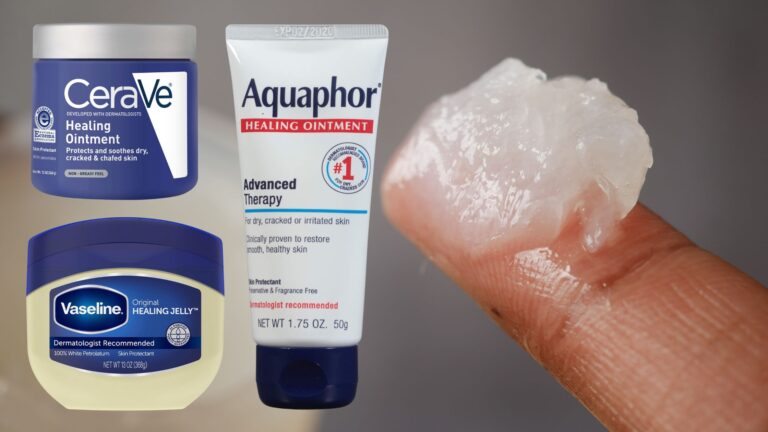Not Sure What Your Skin Type Is? Here’s How to Tell
As a pharmacologist who has spent years studying skin science, I constantly see people confused about their skin type. People walk into stores asking for products for “oily skin” when they actually have dehydrated combination skin, or they avoid moisturizers because they think their sensitive reactions mean they have naturally oily skin.
To determine your skin type, observe your clean skin 2-3 hours after washing. Look for: oil production levels, pore size, sensitivity reactions, and how your skin feels throughout the day.
Getting your skin type wrong isn’t just frustrating. It’s expensive. When you use the wrong products for months or years, you’re essentially working against your skin’s natural needs. Your cleanser might be too harsh, your moisturizer too heavy, or your treatments completely unnecessary.
That’s why I created this guide. Using science-backed methods and years of studying how skin actually works, I’ll show you exactly how to identify your true skin type. No guesswork, just clear answers based on what your skin is actually telling you.

Why Most People Get Their Skin Type Wrong
The biggest mistake I see is that people confuse temporary skin conditions with their actual skin type. Your skin type is determined by genetics and stays relatively consistent throughout your life. Your skin condition, however, changes based on weather, hormones, products, and lifestyle factors.
Take my own skin, for example. My actual skin type is dry to normal, but I’m prone to dehydration. During winter months in dry climates, my skin becomes more sensitive and can feel tight or irritated. If I only observed my skin during winter, I might think I have sensitive skin and choose products that are too gentle to address my actual needs.
This confusion happens because most people assess their skin when something feels wrong. Your skin feels oily after a humid summer day, so you assume you have oily skin. It feels tight after washing, so you think it’s dry. But these temporary feelings don’t tell the whole story.
Seasonal changes make this even trickier. Your combination skin might feel more oily in summer humidity and drier during winter heating season. Product reactions can also mask your true type. If you’re using a cleanser that’s too harsh, even oily skin will feel tight and irritated.
The solution is learning to observe your skin when it’s in its most natural state, and understanding the difference between what you’re feeling and what’s actually happening at a cellular level.
The Science Behind Skin Types
Your skin type is primarily determined by two factors: how much sebum (natural oil) your sebaceous glands produce, and how well your skin barrier functions. These are largely genetic traits that don’t change dramatically over time.
Sebum production is controlled by hormones, particularly androgens like testosterone. Some people naturally produce more sebum, leading to oily skin. Others produce less, resulting in dry skin. The distribution of sebaceous glands across your face also varies, which is why many people have combination skin with an oily T-zone and drier cheeks.
Your skin barrier function determines how well your skin holds onto water and protects against irritants. A strong barrier keeps moisture in and irritants out. A compromised barrier leads to sensitivity, dehydration, and reactivity. You can have oily skin with a compromised barrier (leading to oily but sensitive skin), or dry skin with a strong barrier (dry but resistive). This is why the traditional four-category system sometimes feels inadequate.
Understanding this science helps explain why your friend’s holy grail product might break you out, or why your skin reacts differently to the same product in different seasons. Your genetics set the baseline, but external factors influence how that baseline expresses itself day to day.
The 5 Basic Skin Types Explained
Most dermatologists and skincare professionals use five basic categories to classify skin types. Each has distinct characteristics that you can learn to identify.

Normal Skin
Normal Skin: Balanced oil production with healthy barrier function. Small pores, smooth texture, and few blemishes.
If you have normal skin, you are so lucky. This skin type is not too oily, not too dry, just right. Normal skin produces moderate amounts of sebum and has a healthy, intact barrier function. You’ll notice small, barely visible pores, a smooth texture, and few blemishes. Normal skin tolerates most products well and doesn’t feel tight, oily, or irritated throughout the day. If you have normal skin, consider yourself lucky, but don’t assume you can skip skincare entirely.
Dry Skin
Dry Skin: Insufficient sebum production with compromised barrier function. Tight feeling, flaking, and small pores.
Dry skin produces too little oil and has a weakened protective barrier. You’ll notice tightness after cleansing, flaking, rough patches, and small pores. Your skin looks dull and feels uncomfortable all day. Don’t confuse dry skin with dehydrated skin. Dry skin lacks oil, dehydrated skin lacks water. Dry skin needs oil-based products, dehydrated skin needs water-based hydration.
Wrong pH levels make dry skin worse. Products that are too alkaline strip away what little natural oil you have. Understanding how to balance your skin’s pH helps you choose products that support your skin barrier instead of damaging it.
Oily Skin
Oily Skin: Overactive sebaceous glands producing excess sebum. Visible shine, enlarged pores, and tendency toward acne.
It is characterized by overactive sebaceous glands that produce excess sebum. This shows up as visible shine, especially in the T-zone, enlarged pores, and a tendency toward blackheads and acne. Oily skin often looks thicker and may have a slightly rough texture. The upside with oily skin is that it tends to age more slowly due to natural protection from sebum. Many people with oily skin make the mistake of over-cleansing or using harsh products, which can actually trigger more oil production.
Combination Skin
Combination Skin: Different skin types in different facial zones. Typically oily T-zone with normal to dry cheeks.
It is exactly what it sounds like: different areas of your face have different characteristics. Typically, the T-zone (forehead, nose, chin) is oily while the cheeks are normal to dry. This happens because you have more sebaceous glands in your T-zone. Combination skin can be tricky to treat because different areas have different needs. The key is using targeted treatments rather than applying the same products everywhere.
Sensitive Skin
Sensitive Skin: A skin condition that can occur with any skin type. Reacts easily to products, weather, or environmental factors.
Sensitive Skin isn’t technically a skin type but rather a skin condition that can occur with any of the above types. Sensitive skin reacts easily to products, weather changes, or environmental factors. You might experience redness, burning, stinging, or breakouts from products that others tolerate well. Sensitive skin often indicates a compromised barrier function that allows irritants to penetrate more easily. Also people with sensitive skin may be dealing with a damaged skin barrier rather than a true skin type. Learn how to identify and repair barrier damage here.
Skin Type Quiz
Ready to identify your skin type? This quiz uses scientific observation methods to help you assess your skin accurately. For best results, examine your skin in the morning before applying any products, preferably after you’ve been using gentle, basic products for at least a week.

Quiz Questions:
- How does your skin feel 2-3 hours after cleansing with a gentle cleanser (no products applied)?
- Comfortable and balanced
- Tight and uncomfortable
- Oily, especially in T-zone
- Oily all over
- Varies by area of face
- Look at your pores in natural light. How would you describe them?
- Small and barely visible
- Very small or almost invisible
- Large and visible, especially on nose and cheeks
- Large and visible across entire face
- Large in T-zone, small on cheeks
- How often do you experience breakouts?
- Rarely, maybe around hormonal changes
- Almost never
- Frequently, especially blackheads and whiteheads
- Constantly, various types of blemishes
- Occasionally in T-zone
- How does your skin react to new products?
- Generally well, few reactions
- Sometimes stings or feels tight
- May break out but usually tolerates well
- Often breaks out
- Varies depending on the area and product
- Describe your skin’s appearance by midday:
- Looks the same as morning
- May look slightly dull or feel tight
- Shiny in T-zone
- Shiny all over
- Mixed: shiny in some areas, normal in others
- How does your skin feel in air conditioning or heating?
- No significant change
- Becomes tight and uncomfortable
- May become slightly less oily
- Stays oily
- T-zone stays oily, cheeks may feel tight
Results Interpretation:
- Mostly A answers: Normal skin
- Mostly B answers: Dry skin
- Mostly C answers: Combination skin
- Mostly D answers: Oily skin
- Mixed answers with sensitivity concerns: Sensitive skin (can occur with any type)
Remember, this quiz provides a starting point. Your skin type can have nuances that don’t fit perfectly into one category.
Beyond Basic Types: The Fitzpatrick Scale

Image adapted from sciencebecomesher
While the five basic skin types focus on oil production and sensitivity, the Fitzpatrick Scale adds another crucial dimension: how your skin responds to sun exposure. This classification system, developed by dermatologist Thomas Fitzpatrick, categorizes skin into six types based on melanin content and sun sensitivity.
Understanding your Fitzpatrick type matters because it influences which active ingredients you can use, how your skin ages, and what sun protection you need. People with lighter Fitzpatrick types (I-III) may be more prone to sun damage and certain types of hyperpigmentation, while those with darker types (IV-VI) might experience different aging patterns and post-inflammatory hyperpigmentation more readily.
The Fitzpatrick Scale ranges from Type I (very fair skin that always burns, never tans) to Type VI (very dark skin that never burns). This isn’t just about choosing sunscreen SPF. Different Fitzpatrick types may respond differently to ingredients like retinoids, chemical exfoliants, and vitamin C.
For example, if you have Fitzpatrick Type V or VI skin, you might be more prone to developing dark spots from any inflammation, including minor breakouts. This means your skincare routine should prioritize gentle, anti-inflammatory ingredients alongside your basic skin type needs.
Your Fitzpatrick type doesn’t change your basic skin type, but it adds important information about how to care for your skin safely and effectively.
The Baumann Skin Typing System

Image adapted from Skin type solutions by Dr. Leslie Baumann
While the basic five types work for most people, dermatologists often use a more sophisticated system developed by Dr. Leslie Baumann. The Baumann system recognizes that skin has multiple characteristics that can combine in different ways, creating 16 possible skin types.
Instead of putting you in one category, the Baumann system looks at four different pairs of characteristics. Your skin can be oily or dry, sensitive or resistant, pigmented or non-pigmented, and wrinkled or tight. Each person gets a four-letter code that describes their unique combination.
For example, you might be DSPT: Dry, Sensitive, Pigmented, and Tight. Or ORNW: Oily, Resistant, Non-pigmented, and Wrinkled. This system acknowledges that someone can have oily skin that’s also sensitive, or dry skin that doesn’t wrinkle easily.
The Baumann system is particularly useful for people who don’t fit neatly into traditional categories or who have multiple skin concerns. It helps explain why someone might have oily skin but still experience sensitivity, or why certain anti-aging ingredients work better for some people than others.
While this system is more complex than most people need for daily skincare decisions, it demonstrates an important point: your skin is unique. The basic five types provide a helpful starting framework, but don’t be surprised if your skin doesn’t fit perfectly into one box.
How to Observe Your Skin Like a Professional
Accurate skin type assessment requires systematic observation under consistent conditions. Here’s how to examine your skin the way a dermatologist would.
Step 1: Choose the Right Time Assess your skin first thing in the morning before applying any products. Your skin has had 6-8 hours to regulate itself without interference from cleansers, moisturizers, or environmental factors. This gives you the most accurate picture of your skin’s natural state.
Step 2: Use Proper Lighting Natural light near a window is ideal, but if that’s not available, use bright, white light. Avoid yellow bathroom lighting or dim conditions that can make it hard to see your skin’s true condition.
Step 3: Examine Zone by Zone Your forehead, nose, cheeks, and chin can all have different characteristics. Don’t assume your entire face has the same skin type. Look at pore size, oil production, texture, and any areas of sensitivity or irritation in each zone.
Step 4: Perform the Tissue Test Gently press a clean tissue to different areas of your face. Oily areas will leave visible oil on the tissue, while dry areas won’t. This simple test can help you identify combination skin patterns.
Step 5: Track Changes Over Time Your skin can shift with seasons, hormonal changes, or lifestyle factors. Reassess your skin type every few months, especially if your current routine stops working or if you notice significant changes.
Step 6: Consider Your Skin’s History Think about how your skin has behaved over the past few months, not just today. One day of oiliness after a poor night’s sleep doesn’t mean you have oily skin, just like one day of tightness during dry weather doesn’t mean you have dry skin.
Pay attention to how your skin responds to different products and environmental conditions. This information is just as valuable as what you see in the mirror.
Common Skin Type Myths Debunked
Myth: “Oily skin doesn’t need moisturizer.” This is completely false and potentially harmful. Oily skin still needs hydration and barrier support. When you skip moisturizer, your skin may actually produce more oil to compensate for the lack of surface protection. The key is choosing lightweight, non-comedogenic moisturizers that won’t clog pores.
Myth: “You can change your skin type with the right products.” Your basic skin type is genetic and doesn’t fundamentally change. However, you can improve your skin’s condition, manage excess oil production, and strengthen your barrier function. What you’re changing is how your skin type expresses itself, not the underlying type itself.
Myth: “Expensive products work better for all skin types.” Price doesn’t determine effectiveness. Many affordable products contain the same active ingredients as luxury brands. What matters is choosing products with ingredients that address your specific skin type’s needs, regardless of cost.
Myth: “Natural ingredients are always gentler.” This is particularly dangerous for people with sensitive skin. Many natural ingredients are potent irritants or allergens. Poison ivy is natural, but you wouldn’t put it on your face. Similarly, essential oils, citrus extracts, and many botanical ingredients can cause reactions in sensitive individuals.
Myth: “Your skin type changes dramatically with age.” While your skin’s needs evolve as you age, your basic type remains relatively consistent. A 20-year-old with oily skin will likely still have oily skin at 40, though they may also develop age-related concerns like fine lines or loss of elasticity.
Understanding these myths helps you make better decisions about your skincare routine and avoid products or advice that could actually make your skin worse.
Conclusion and Next Steps
Identifying your true skin type is the foundation of effective skincare. By understanding whether you have normal, oily, dry, combination, or sensitive skin, you can choose products and routines that work with your skin’s natural characteristics rather than against them.
Remember these key points: assess your skin in its most natural state, consider multiple factors beyond just oil production, and don’t expect your skin to fit perfectly into one category. Your skin is unique, and your routine should reflect that uniqueness.
Your skin type isn’t static throughout the year. Hormonal changes, seasonal shifts, and life circumstances can all influence how your skin behaves. Plan to reassess your skin type every few months, especially if your current routine stops working or if you notice significant changes.
Most importantly, be patient with the process. It can take several weeks of consistent, gentle skincare to see your skin’s true character, especially if you’ve been using products that aren’t right for your type.
Now that you know your skin type, you’re ready to build a routine that actually works. In upcoming posts, I’ll break down specific product recommendations and routines for each skin type, including how to adjust your routine for seasonal changes and life transitions.
Your skin is worth the effort to understand it properly. Take the time to observe, assess, and choose products thoughtfully. Your future self will thank you for the investment.
FAQ
References
- Oliveira, R.; Ferreira, J.; Azevedo, L.F.; Almeida, I.F. An Overview of Methods to Characterize Skin Type: Focus on Visual Rating Scales and Self-Report Instruments. Cosmetics 2023, 10, 14. https://doi.org/10.3390/cosmetics10010014







